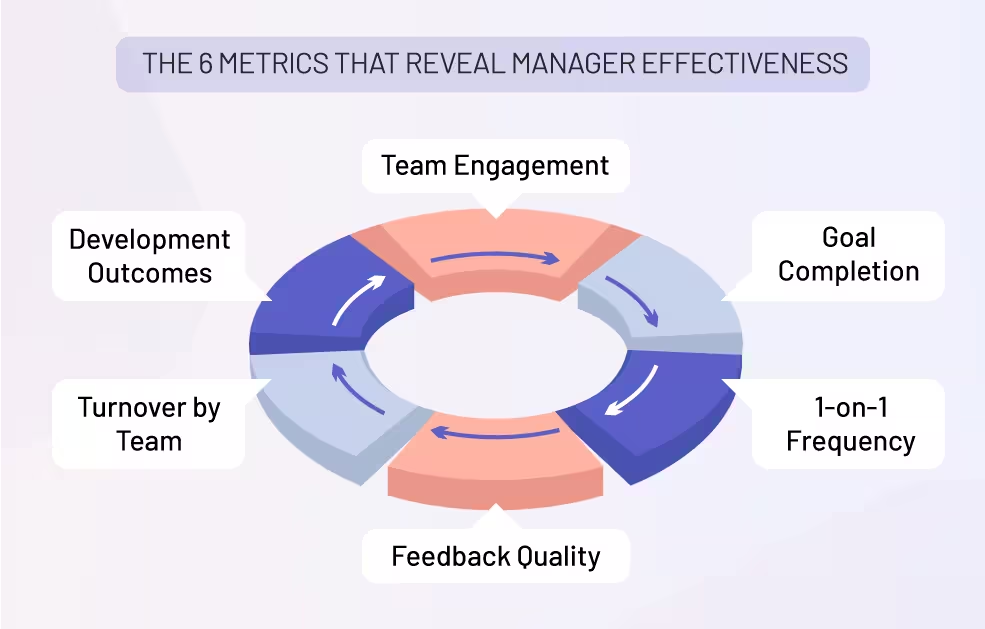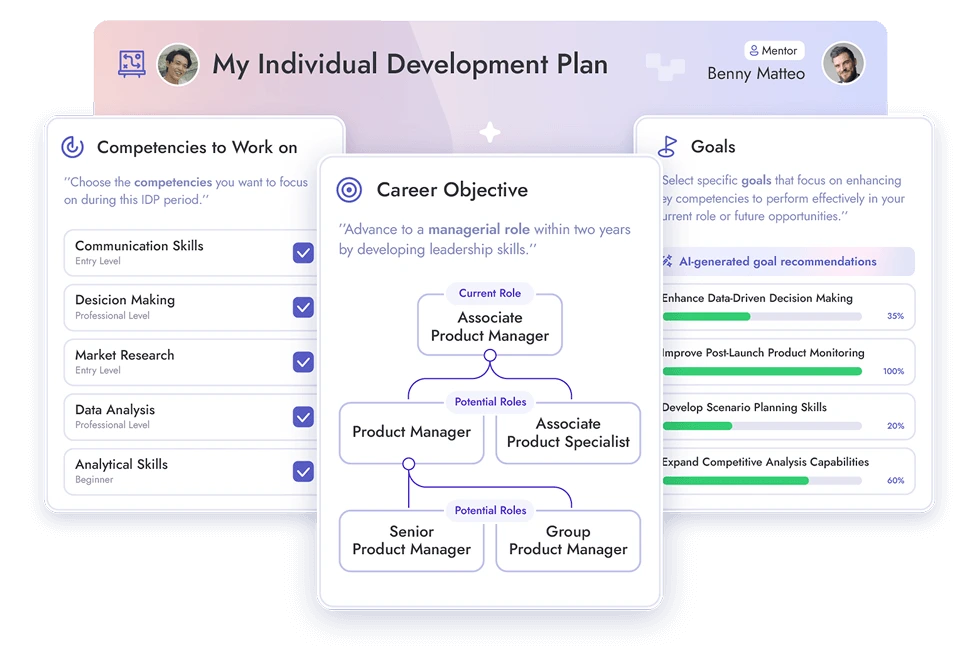Leadership quality determines whether teams thrive or merely survive. The numbers support this claim: managers account for 70% of the variance in employee engagement across organizations. Yet most companies still lack a reliable system to evaluate the people who hold this much influence over their workforce.
Traditional annual reviews don't capture the full scope of manager effectiveness. A modern manager evaluation framework must combine quantitative performance reviews and KPIs with qualitative 360-degree feedback and ongoing leadership development insights. This approach provides the complete picture that HR teams and senior leaders need to identify strengths, address gaps, and build better managers.
Teamflect brings these elements together in one platform. With integrated reviews, goals, and feedback all inside Microsoft Teams, organizations can evaluate manager performance without adding complexity to their existing workflows.
A manager performance evaluation is a structured process that assesses how effectively someone leads, develops, and delivers results through their team. It differs from other evaluation types, in such a way that:
The table below summarizes how performance evaluations differ across key organizational roles, highlighting the distinct focuses and success indicators:
It’s important to note that manager evaluations require a dual focus. They measure business outcomes like goal completion and team productivity. They also measure relationships, including team trust, development quality, and psychological safety. Both dimensions matter equally.
The traditional view of management is no longer sufficient in the modern workplace. Effective manager evaluation has become a critical business imperative, directly tying leadership quality to organizational survival and success. Various research and insights demonstrate why this focus is so crucial.
The cost of ineffective management is staggering. According to Gallup's State of the Global Workplace report, as mentioned by SHRM, declining employee engagement cost the global economy $438 billion in lost productivity, with manager disengagement identified as the primary driver.
When managers lack the skills to coach, communicate, or create trust, their teams suffer directly, leading to increased turnover and a weakened organizational culture.
The problem often stems from a fundamental disconnect. Research from Deloitte highlights that while 94% of employees and 96% of managers agree that managers are responsible for their team's wellbeing, a gap persists.
Nearly a third of employees (32%) feel their manager simply doesn’t care. The Deloitte data reveals specific shortfalls: only 54% of managers regularly check in on how their employees are doing, just 48% ensure workloads are reasonable, and a mere 37% make sure their teams use paid time off.
That failure in basic support prevents managers from fulfilling what Harvard Business Review research on over 100 countries identified as their most critical value-creating function: matching people to roles where they can best succeed.
Recognizing these high stakes, modern HR teams now prioritize continuous evaluation over annual reviews. The strategic shift moves the focus from judgment to growth and enablement.
Regular assessment helps managers improve before problems escalate, signaling that the organization is investing in leadership development as a core strategy to boost retention and productivity.

Effective manager evaluation rests on three complementary pillars. Each provides different insights that, when combined, create a complete picture of leadership effectiveness.
The first pillar uses traditional performance reviews to evaluate concrete outcomes and leadership competencies. The second pillar adds 360-degree feedback to capture perspectives from people who work with the manager daily. The third pillar tracks quantitative metrics that reveal patterns over time.
Organizations that use all three pillars gain advantages over those that rely on one or two. They spot problems earlier, provide more targeted coaching, and build stronger manager pipelines.
Start by aligning leadership competencies with your business strategy. Generic competency lists don't work because different organizations need different things from their managers. A fast-growing startup needs managers who handle ambiguity and rapid change. A mature enterprise needs managers who maintain consistency and develop deep expertise.
Common competencies include:
Create a competency framework or scorecard that defines what good looks like at each level. This framework becomes your evaluation foundation. Use the sample matrix below as your guide.
Blend quantitative and qualitative methods for a balanced view. Using both prevents bias and creates a more accurate assessment.
Each method has strengths:
Consider how much weight to assign each method. A common approach allocates 40% to goal achievement, 30% to 360-degree feedback, and 30% to team metrics. Adjust these percentages based on what matters most in your organization.
To get a complete picture of a manager's performance, it's essential to use methods that gather input from all directions. Incorporating 360° feedback is a core best practice for achieving this comprehensive view.
As a feedback software, Teamflect collects and integrates upward feedback directly in the review cycle. Managers receive consolidated insights without seeing individual responses, which protects anonymity while delivering actionable information.

Focus review forms on competencies, team outcomes, and leadership behaviors rather than just goal completion. A manager might hit all their targets while burning out their team. The review process should surface this disconnect.
Use a five-point rating scale for consistency across the organization. Pair ratings with open-ended questions that prompt specific examples:
Encourage a mix of self-evaluation and manager-of-manager feedback. Self-assessment helps managers reflect on their growth areas before receiving input from others. The manager's manager provides perspective on strategic contribution and organizational impact.
Structure templates with clear categories:
This method helps reviewers provide balanced feedback across all leadership dimensions.

Quantitative metrics validate and complement qualitative feedback. Track these six metrics to build a complete picture of manager effectiveness:
These metrics work together to show patterns that individual data points miss. A manager with high goal completion but also high turnover might be driving results through unsustainable pressure. The combination reveals the problem.
Finalizing a manager's review requires moving past simple data collection to thoughtful analysis and standardization. Here are some of the best practices for analyzing the collected information and ensuring the final ratings are fair, consistent, and actionable.
As a performance review software, Teamflect visualizes these insights automatically. The platform pulls data from reviews, feedback cycles, and goal tracking to create comprehensive manager scorecards without manual reporting work.
After thoroughly analyzing and calibrating the results, the most critical step is translating those findings into tangible change. Follow these to effectively drive action, ensuring the effort put into the evaluation process results in genuine managerial and organizational growth:
Teamflect connects review outcomes to development goals automatically. When a manager receives constructive feedback about communication gaps, HR can assign relevant training and track completion alongside other goals. This integration closes the loop between evaluation and growth.
Organizations make predictable errors when evaluating manager performance. Avoid these five problems to build a more effective evaluation system.
Evaluating leadership effectively is a cornerstone of successful talent management and organizational growth. Modern organizations adopt strategic approaches to leadership evaluation that promote honest feedback, continuous development, and fairness.
The following best practices outline how companies can optimize leadership reviews to enhance manager performance and drive employee engagement.
Separating leadership evaluations from compensation conversations prevents managers from focusing solely on defending their performance. When reviews are tied directly to raises, feedback may become less candid and more self-protective.
Conduct evaluation discussions first, focused on growth and learning, and hold compensation meetings weeks later to maintain clarity and trust.
Regular calibration sessions, held quarterly, help senior leaders align evaluation standards across divisions and prevent rating inflation. As organizations grow and more executives engage in leadership reviews, calibration ensures consistent, equitable assessments and strengthens the integrity of performance data.
Integrating AI tools with human insight enhances the evaluation process. AI can detect patterns in employee engagement data, goal achievement, and sentiment from feedback, offering a broad analytical perspective. Meanwhile, human evaluators provide essential context that explains those patterns and guides meaningful development actions.
Waiting for annual or semi-annual reviews to address manager performance gaps is insufficient. Metrics and feedback should trigger immediate coaching interventions, resources, or training to correct issues promptly. This approach encourages continuous improvement and prevents small challenges from becoming major problems.
Giving managers early access to aggregated feedback themes fosters openness and self-awareness. Understanding team perceptions ahead of formal evaluations often motivates managers to self-correct and align their leadership behaviors, contributing to a healthier, more responsive management culture.

Evaluating managers well requires the right combination of reviews, feedback, and metrics. When these elements work together, organizations build stronger leadership pipelines and create cultures where managers help their people succeed.
Teamflect simplifies manager evaluation by bringing all the necessary components into Microsoft Teams. The platform combines structured performance reviews, 360-degree feedback templates, goal tracking, and analytics dashboards in one place. HR teams can launch comprehensive manager evaluations without juggling multiple tools or spreadsheets.
Individual contributor evaluations focus on personal task execution, output quality, and skill development. Manager evaluations assess both results and relationships. They measure how effectively someone leads others, develops talent, and creates team performance. Managers succeed by enabling their people, not just by completing their own work.
Conduct formal manager reviews at least annually, with quarterly check-ins to track progress on development goals. Some organizations run lighter 360-degree feedback cycles twice per year to maintain continuous improvement. The key is balancing thoroughness with sustainability. Annual deep dives work well when supported by regular coaching conversations.
360° feedback captures perspectives that managers' supervisors can't see. Direct reports observe daily coaching quality and communication effectiveness. Peers see collaboration skills and cross-functional influence. This multi-source input identifies blind spots and provides more accurate assessment than single-perspective reviews. It also reduces bias by aggregating multiple viewpoints.
Track team engagement scores, goal completion rates, turnover by team, 1-on-1 meeting frequency, feedback quality ratings, and employee development outcomes. These six metrics together reveal whether a manager drives results while building a healthy team culture. No single metric tells the full story, but the combination provides reliable insight into leadership quality.
Use calibration sessions where senior leaders review ratings together and discuss discrepancies. Combine multiple data sources including 360-degree feedback, metrics, and structured reviews.
Apply consistent performance rating scales across all managers. Train raters to recognize common biases like recency effect and halo effect. Anonymous feedback helps people share honest input without fear of retaliation.
An all-in-one performance management tool for Microsoft Teams
